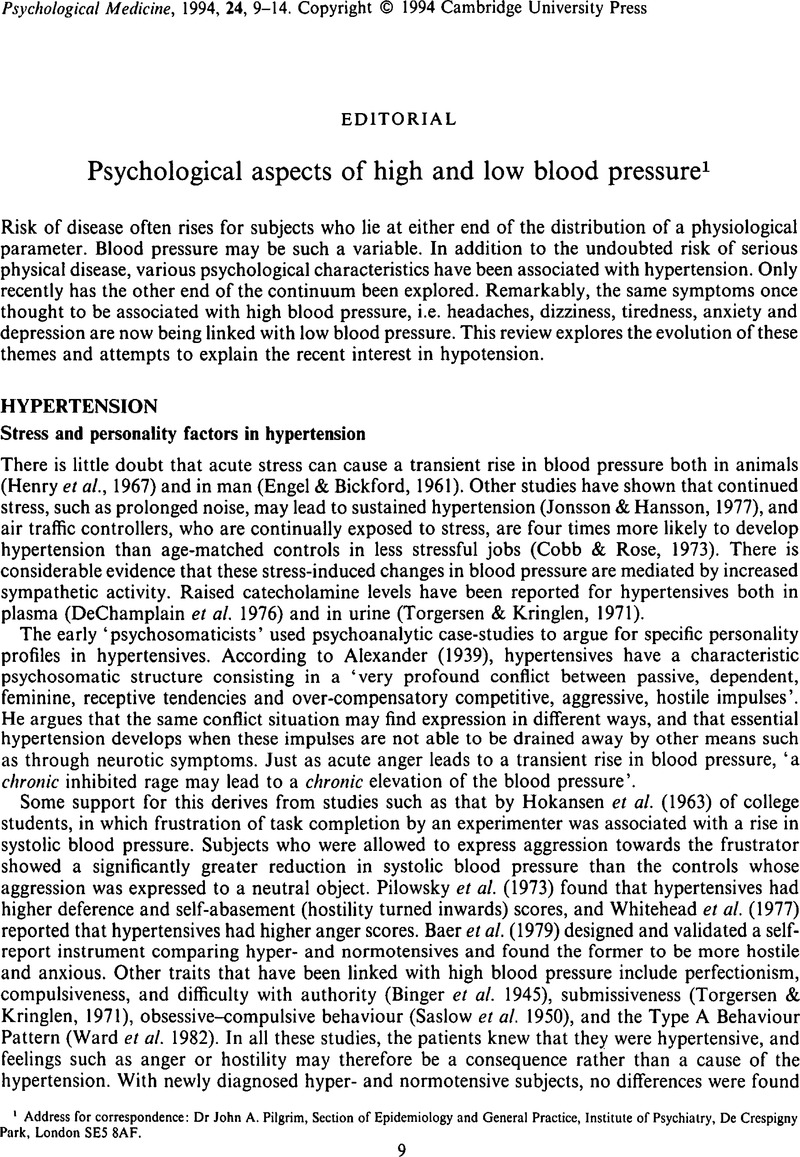Crossref Citations
This article has been cited by the following publications. This list is generated based on data provided by Crossref.
Brody, Stuart
Veit, Ralf
and
Rau, Harald
1996.
Neuroticism but not cardiovascular stress reactivity is associated with less longitudinal blood pressure increase.
Personality and Individual Differences,
Vol. 20,
Issue. 3,
p.
375.
Nyklíc̆ek, Ivan
Vingerhoets, Ad J.J.M.
Van Heck, Guus L.
Kamphuis, Pieter L.
Van Poppel, Joop W.M.J.
and
Van Limpt, Monique C.A.M.
1997.
Blood pressure, self-reported symptoms and job-related problems in schoolteachers.
Journal of Psychosomatic Research,
Vol. 42,
Issue. 3,
p.
287.
Brody, Stuart
Angrilli, Alessandro
Weiss, Ute
Birbaumer, Niels
Mini, Alessio
Veit, Ralf
and
Rau, Harald
1997.
Somatotosensory evoked potentials during baroreceptor stimulation in chronic low back pain patients and normal controls.
International Journal of Psychophysiology,
Vol. 25,
Issue. 3,
p.
201.
Paterniti, Sabrina
Alperovitch, Annick
Ducimetiere, Pierre
Dealberto, Marie-Jose
Lepine, Jean-Pierre
and
Bisserbe, Jean-Claude
1999.
Anxiety But Not Depression Is Associated With Elevated Blood Pressure in a Community Group of French Elderly.
Psychosomatic Medicine,
Vol. 61,
Issue. 1,
p.
77.
Shen, S.
and
Ingenito, A. J.
1999.
Depressor Effect of Kappa Opioid Agonist on Hypertension Induced by Isolation in the Rat.
Clinical and Experimental Hypertension,
Vol. 21,
Issue. 3,
p.
275.
Nettleton, Barbara
Cooksey, Elizabeth
Mordue, Alan
Dorward, Ishbel
Ferguson, John
Johnston, Judy
and
Jones, Lyn
2000.
Counselling: filling a gap in general practice.
Patient Education and Counseling,
Vol. 41,
Issue. 2,
p.
197.
Weisz, Nathan
Schandry, Rainer
Jacobs, Arthur M
Mialet, Jean-Paul
and
Duschek, Stefan
2002.
Early contingent negative variation of the EEG and attentional flexibility are reduced in hypotension.
International Journal of Psychophysiology,
Vol. 45,
Issue. 3,
p.
253.
Wick, Jeannette Y.
and
Zanni, Guido R.
2004.
IN THE ELDERLY.
The Consultant Pharmacist,
Vol. 19,
Issue. 3,
p.
195.
Grubb, Blair P.
Calkins, Hugh
and
Rowe, Peter C.
2005.
Syncope: Mechanisms and Management.
p.
225.
Rafanelli, Chiara
Offidani, Emanuela
Gostoli, Sara
and
Roncuzzi, Renzo
2012.
Psychological correlates in patients with different levels of hypertension.
Psychiatry Research,
Vol. 198,
Issue. 1,
p.
154.
de Zambotti, Massimiliano
Covassin, Naima
Cellini, Nicola
Sarlo, Michela
Torre, Jacopo
and
Stegagno, Luciano
2012.
Hemodynamic and autonomic modifications during sleep stages in young hypotensive women.
Biological Psychology,
Vol. 91,
Issue. 1,
p.
22.
Sarlo, Michela
de Zambotti, Massimiliano
Gallicchio, Germano
Devigili, Andrea
and
Stegagno, Luciano
2013.
Impaired cerebral and systemic hemodynamics under cognitive load in young hypotensives: a transcranial Doppler study.
Journal of Behavioral Medicine,
Vol. 36,
Issue. 2,
p.
134.
Covassin, Naima
de Zambotti, Massimiliano
Cellini, Nicola
Sarlo, Michela
and
Stegagno, Luciano
2013.
Cardiovascular down‐regulation in essential hypotension: Relationships with autonomic control and sleep.
Psychophysiology,
Vol. 50,
Issue. 8,
p.
767.
Kovács, Katalin Réka
Bajkó, Zoltán
Szekeres, Csilla Cecília
Csapó, Krisztina
Oláh, László
Magyar, Mária Tünde
Molnár, Sándor
Czuriga, Dániel
Kardos, László
Burainé, Andrea Bojtor
Bereczki, Dániel
Soltész, Pál
and
Csiba, László
2014.
Elevated LDL-C combined with hypertension worsens subclinical vascular impairment and cognitive function.
Journal of the American Society of Hypertension,
Vol. 8,
Issue. 8,
p.
550.
Wada, Masahiro
Miwa, Syunta
Mameno, Tomoaki
Suganami, Tohru
Ikebe, Kazunori
and
Maeda, Yoshinobu
2016.
A prospective study of the relationship between patient character and blood pressure in dental implant surgery.
International Journal of Implant Dentistry,
Vol. 2,
Issue. 1,
Duschek, Stefan
Hoffmann, Alexandra
Bair, Angela
Reyes del Paso, Gustavo A.
and
Montoro, Casandra I.
2018.
Cerebral blood flow modulations during proactive control in chronic hypotension.
Brain and Cognition,
Vol. 125,
Issue. ,
p.
135.
Jacob, Giris
Barbic, Franca
Glago, Meytal
Dipaola, Franca
Porta, Alberto
and
Furlan, Raffaello
2018.
Cardiovascular autonomic profile in women with constitutional hypotension.
Journal of Hypertension,
Vol. 36,
Issue. 10,
p.
2068.
Duschek, Stefan
Hoffmann, Alexandra
Montoro, Casandra I.
Bair, Angela
Reyes del Paso, Gustavo A.
and
Ettinger, Ulrich
2019.
Cerebral blood flow modulations during antisaccade preparation in chronic hypotension.
Psychophysiology,
Vol. 56,
Issue. 3,
Duschek, Stefan
Hoffmann, Alexandra
Montoro, Casandra I.
and
Reyes del Paso, Gustavo A.
2019.
Autonomic Cardiovascular Dysregulation at Rest and During Stress in Chronically Low Blood Pressure.
Journal of Psychophysiology,
Vol. 33,
Issue. 1,
p.
39.
OLMO GONZÁLEZ, Belisa
GONZÁLEZ-MARTÍN, Miguel ángel
OLMO-VİLLASECA, José Manuel
MAÑES-MEDİNA, Anna
and
RİBERA-URİBE, Manuel
2019.
The Impact of Dental Treatments on Blood Pressure Variations.
Cumhuriyet Dental Journal,
Vol. 22,
Issue. 1,
p.
74.



